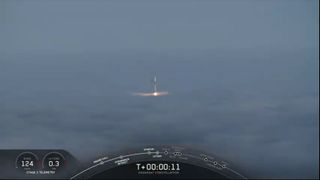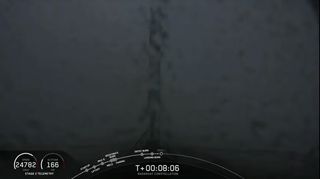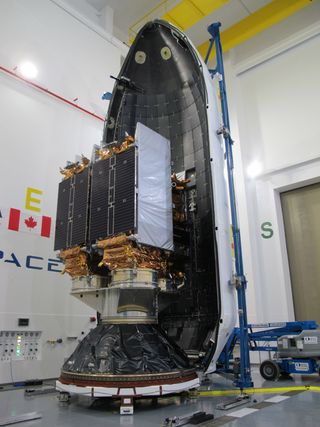SpaceX successfully launched its seventh space mission of the year Wednesday (June 12), delivering a trio of Earth-observing satellites into orbit for Canada and nailing a foggy landing in California.
Despite a thick layer of morning fog, the SpaceX Falcon 9 rocket lifted off from Vandenberg Air Force Base at 10:17 a.m. EDT (1417 GMT; 7:17 a.m. local California time), carrying Canada's RADARSAT Constellation Mission (RCM) skyward. The three satellites were released in orbit about an hour after liftoff, SpaceX announced via Twitter.
About 8 minutes after liftoff, the the two-stage Falcon 9's first stage stuck its landing in the center of LZ-4, SpaceX's landing pad at Vandenberg, gently touching down a mere quarter-mile (0.4 kilometers) from where it launched. This marked the company's 41st booster recovery.
Related: See the Evolution of SpaceX's Rockets in Pictures
The first stage was the same booster that ferried SpaceX's Crew Dragon capsule to the International Space Station (ISS) in March of this year. That uncrewed flight, known as Demo-1, was the first-ever mission for the capsule, which proved it could autonomously dock to, and undock from, the space station before returning to Earth.

A SpaceX Falcon 9 rocket carrying three Radarsat satellites for Canada lifts off in thick fog at Vandenberg Air Force Base in California on June 12, 2019.
(Image: © SpaceX)

A view of the Falcon 9 rocket emerging above the fog layer as it launches the Radarsat satellites from Vandenberg Air Force in California on June 12, 2019.
(Image: © SpaceX)

Left: A view of the landing burn by a SpaceX Falcon 9 rocket as it returned to Earth following the successful Radarsat launch on June 12, 2019. At right: The fog layer at California's Vandenberg Air Force Base at the time of landing.
(Image: © SpaceX)

The first stage of a Falcon 9 rocket stands atop the company's Landing Zone 4 pad at Vandenberg Air Force Base after nailing its second landing on June 12, 2019.
(Image: © SpaceX)
Following that flight, the booster had landed safely at sea, before getting hauled back to land. Now it stands tall at LZ-4, as only the second SpaceX booster to touch down on California soil.
Following a rocket launch, SpaceX has two possible options for recovering boosters: returning to land, using a specially constructed landing pad, or touching down at sea, on the deck of one of the company’s two drone ships. The option the company picks varies between launches, predominantly determined by the rocket's payload.
Coming all the way back to land requires more fuel than landing on a ship at sea, so launches that use lots of propellant during ascent (typically toting very large, very heavy payloads) usually have to land in the ocean. But rockets carrying lighter loads, in particular ones bound for low-Earth orbit, have plenty of fuel left to head back to land.
Today's flight marked the 41st landing for SpaceX out of 72 total launches for the company; only 15 of these touchdowns have been on land. And this is only the second time a rocket has landed on solid ground in California; SpaceX's other ground landings have occurred on Florida's Space Coast, where the company has a pair of launch and landing pads.
But SpaceX has always intended to land rockets back at its Vandenberg facilities, Space Launch Complex 4 (SLC-4 for short). Originally home to Titan missiles, SLC-4 is actually two launch sites in one. Split up into two parts — east and west — SpaceX leases both and uses one for launching and one for landing.
Before today, all but one of the company's West Coast landings had taken place on the drone ship "Just Read the Instructions." Last October, SpaceX made its first "return to launching site landing," or RTLS, at Vandenberg, acing a Falcon 9 touchdown shortly after the launch of the SAOCOM-1A satellite. (The company leased the landing zone from the Air Force in 2015 but only recently obtained clearance to activate it.)
Related: See Amazing Photos of SpaceX's SAOCOM-1A Launch

The three Radarsat Constellation Mission satellites are seen together as SpaceX enshrouded them with a payload fairing (background) for a June 12, 2019 launch on a Falcon 9 rocket at Vandenberg Air Force Station, California.
(Image: © MDA, a Maxar company, Canadian Space Agency)
Real estate at Vandenberg is limited, and as such the Falcon 9 first stage must land a mere 1,400 feet (430 meters) from where it lifts off, which adds a degree of difficulty to the landing. That means if anything goes awry, an explosion could potentially knock out the launch pad and other nearby facilities.
At Florida's Cape Canaveral Air Force Station, the launch and landing zones are several miles apart, which is one reason why SpaceX chose it as the first landing site.
The success of today's land landing further bolsters the notion that SpaceX won't have to rely solely on its drone ship to recover boosters shot from its West Coast facilities. Not having to dispatch recovery vessels each time means the boosters can return to service more quickly. Additionally, land landings mean that the boosters aren't exposed to potential corrosion from salty sea water, which translates to reduced post-launch processing times.
Tucked inside the Falcon 9's payload fairing today was a set of three satellites launched on behalf of the Canadian Space Agency (CSA). The RADARSAT Constellation Mission, a $1.2 billion project, consists of three identical satellites developed by MacDonald, Dettwiler and Associates, a subsidiary of Maxar Technologies.
The three satellites will use radar to locate ships, monitor ecosystems and keep a watchful eye on the Arctic. Their purpose is to replace the aging RADARSAT-2 satellite, which has been in orbit since 2007. RADARSAT-2 was designed to last only seven years but will remain in operation until the new constellation is up and running.
Once operational, the constellation will orbit our planet approximately 370 miles (600 km) overhead, beaming data down to the Canadian government. They are expected to generate around 250,000 images per year, which will help them play a key role in monitoring changes in climate, especially in the largely uninhabited, remote regions of Northern Canada.
Editor's note: This story was updated at 11:30 a.m. EDT with the news that all three satellites had deployed successfully.
Follow Amy Thompson on Twitter @astrogingersnap. Follow us on Twitter @Spacedotcom or Facebook.
Bagikan Berita Ini














0 Response to "Used SpaceX Rocket Launches 3 Radarsat Satellites, Aces Foggy Landing - Space.com"
Post a Comment